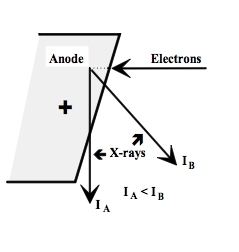 | ||
In X-ray tubes, the heel effect or more accurately, the anode heel effect is a variation of the intensity of X-rays emitted by the anode depending on the direction of emission. Due to the geometry of the anode, X-rays emitted towards the cathode are in general more intense than those emitted perpendicular to the cathode–anode axis. The effect stems from the absorption of X-ray photons before they leave the anode in which they are produced. The probability of absorption depends on the distance the photons travel within the anode material, which in turn depends on the direction of emission.
Contents
Source to Image Distance (SID)
The distance from the anode (source of X-rays) to the image receptor greatly influences the apparent magnitude of the anode heel effect. The shorter the distance, the less space the beam has to diverge. The effect is less noticeable at larger source-image distances (SID).
Beam and receptor size
Diagnostic X-ray beams can be collimated to large or small beams. A large beam will emit more intensities of the beam along the cathode-anode axis than a small beam. A large image receptor will also capture more of this beam than a small receptor. Both of these factors will greatly influence the visibility of the anode heel effect. A smaller field size results in a less pronounced heel effect.
Anode angle
When the angle of the anode is great, the usable X-ray photons will not have to travel through as much of the anode material to exit the tube. This results in a much less apparent anode heel effect, though the effective focal spot size is increased.
Solutions
Almost all modern diagnostic x-ray machines exhibit the heel effect to some degree. Its effect on images is mostly avoided through consideration of patient positioning. For example, when imaging a foot which is thicker at the ankle end than the toes, the toes should be positioned towards the anode and the ankle towards the cathode.
There have also been some efforts to eliminate the heel effect through automatic software adjustment of pixel values.
